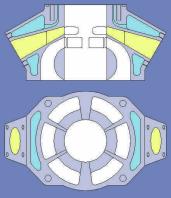




However, the type described as
reverse flow scavenging is being reborn
with modern ideas. The new version is
called the FST or FOS scavenging
system and is being tested in 50 cc
racing motorcycles. The advantage is
that both exhaust and transfer ports can
wrap completely around the cylinder
wall, giving lots of time area. Especially
blow down time area. This better
breathing allows more rpm, therefore
more power. The problem is creating a
good scavenging flow with minimal
mixing and little loss out the exhaust.
The idea is illustrated below.
Notice the transfer and exhaust
passages look very much like those of
the Aprilia 125 except that they go
completely around the cylinder. The
problem is to create a stable column of
air in the center of the cylinder to force
out the residual exhaust. Is it possible
with, around the same scavenging
efficiencies as the loop systems?
PROPWASH
4
April 2013
High Power Two Stroke Design Part 2
(Continued from page 3)
Both the double piston and poppet valve exhaust
engine are in use today, but both have limitations for
high power use. The poppet valve flow is limited both by
restricted area and opening speed, so the maximum rpm
is limited compared to ports. Lots of large two stroke
diesels use this system since high speed isn’t needed. The
double piston engine is mechanically complex, but
otherwise has formed the basis of some very successful
engines. See the Eco Motors engine illustrated in part 1
of the November 2012
Propwash
. The sleeve valve is
less complex and doesn’t suffer from immediate rpm
limitations. However, it has never been fully developed.
Because the jet engine was obviously superior for
aircraft, the development before and during World War
II of the only two stroke engine using a sleeve valve, the
Rolls Royce Crecy, was stopped. Single cylinder test
versions of this engine were supercharged to brake mean
effective pressures of over 350 psi (24 bar).
As was also pointed out in part 1, the tuned pipe,
taking advantage of the pulsating nature of the two
stroke engine, revolutionized two stroke thinking. Its performance made up for poorer
scavenging in the simple engine. The picture below shows a comparison of the various
types of scavenging systems used in simple engines. Model engines have used all but
the uniflow type for a long time, but performance seems to be best with loop
scavenged engines so far.
Crecy Sleeve Valve Cylinder